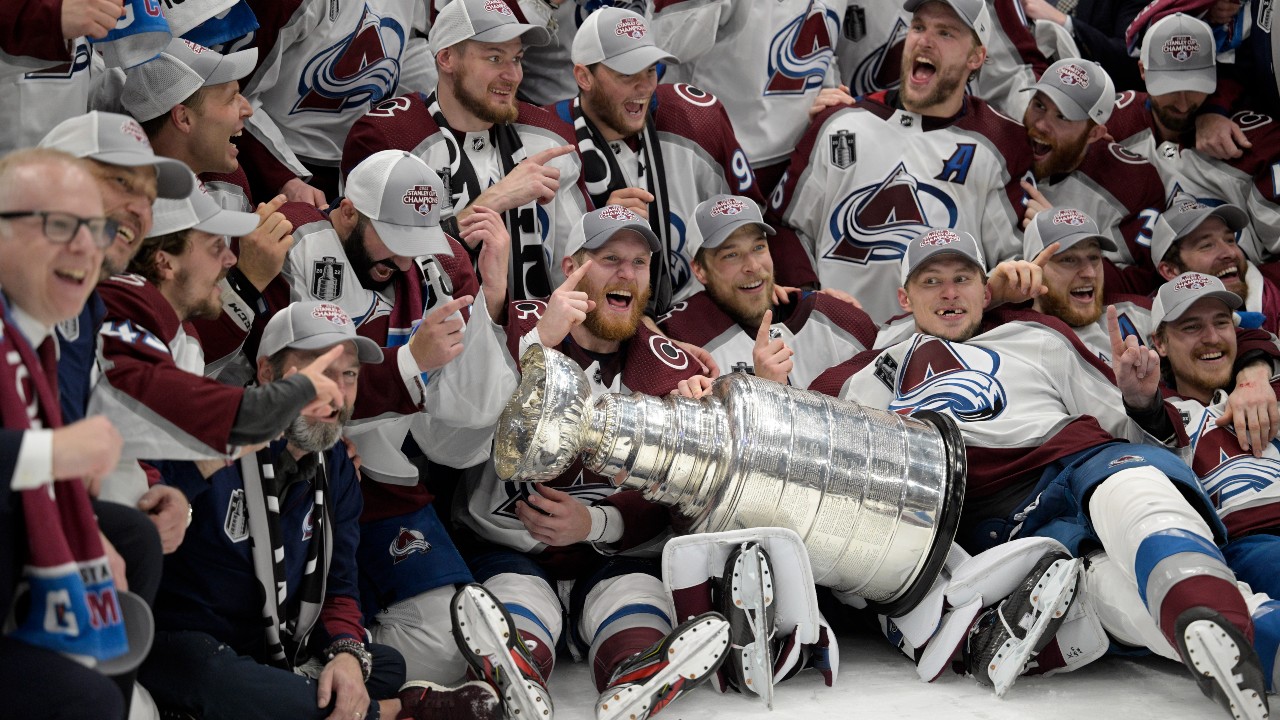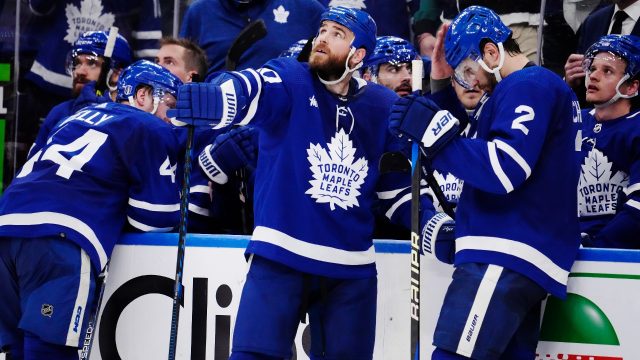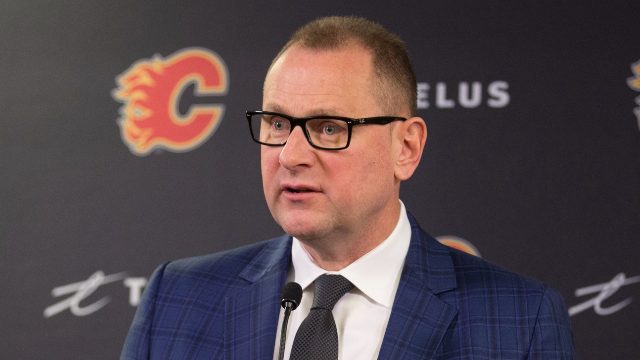The Toronto Maple Leafs may feel like a bit of a mess, but despite the disarray there’s a case to be made it’s a good kind of mess. If you’ve ever moved cities, life can feel messy for a while, with your stuff in boxes and getting acclimated to a new environment. Moving into a new job can feel messy, starting a new relationship the same, but the reason people make these changes is the belief that with them, life can get better.
As sloppy as the “firing” of former-GM Kyle Dubas feels, a less emotional perspective sees the Leafs’ vacant GM job as an awfully attractive spot when things calm down enough to once again focus on hockey.
The team is fresh off a 111-point season where they actually won a playoff round and are a year removed from a 115-point regular season. The core players from those (relative!) successes are all under contract for next season, and three of them are prime-aged talents. The biggest change from seasons past is that thanks to the unloading of bad deals and bargain hunting at the fringes, the Leafs have roughly $20 million in salary cap space to play with this off-season, the most they’ve had in years. They’re also adding a quality power forward on the cheap in Matthew Knies (hurray entry-level deals in the oppressive post-pandemic cap era!). There’s no reason why Toronto should take a step back, and several why they should improve.
And so with that reality, I wanted to evaluate just what the state of affairs are for the Maple Leafs, to better evaluate what exactly they’re hiring Dubas’ replacement to sort out. I painted the rosy picture of the “mess” above, but like with any major change, there are details to contend with – often big ones – and the Leafs GM job is no different.
What’s the next Leafs GM walking into?
Expectations
GMs who walk into terrible organizations that need to start over have the best opportunity. Few ever say this out loud, but the main job for most general managers is … to keep their job as general manager. At the very least the twin goals of “win a Cup” and “don’t get fired” are neck and neck at the top of the list – there aren’t that many of these jobs, they pay a lot, and come with a lot of authority. So with a bad team you get to present a vision, spend a couple seasons on the tear down, a couple building up, and in Year 5 people start to judge your work.
That ain’t the Leafs’ situation.
At the peak of the careers of Auston Matthews, Mitch Marner, and William Nylander, and after a second-round playoff exit, the only thing that’s acceptable is to be better than that. The team has been dying for this kind of cap flexibility, and with a huge number of UFAs on the roster (including players like Alex Kerfoot and Justin Holl, who combined to make $5.5 million per year for the privilege of angering fans), the Leafs can finally add some pieces they’ve coveted.
Fans in Toronto expect success, and they expect it tomorrow.
High stakes, high risks, high rewards
There are reasons mentioned above why this team should be pretty good, and with those is the reality that actually delivering success – like, God forbid, bringing a Cup to Toronto – means becoming something close to hockey immortality. The odds are long, of course, but if you’re a top-half team — which the Leafs are — you’ve got a shot. The chance to achieve that as a hockey person is a huge reason so many would desire the Leafs’ GM job.
Now, the opposite is of course true as well. If you fail here, you’ll fail spectacularly, and it won’t be a failure you can easily wash off.
High stakes, those.
Speaking of…
The big four contracts
It would be hard to conduct an evaluation of the Leafs and conclude their core should “run it back” for another try after so many failures. But with Matthews and Nylander up for extensions in five weeks, and no-trade clauses kicking in for both them and Mitch Marner, you have massive decisions to make immediately.
Almost nobody wants to come in and make a huge trade right out of the gates. It’s the opposite of the “stay employed for five years before being judged” strategy. But here, given the context of the situation, not doing anything is worth harsh judgement. (My gut here is whoever gets the job is going to want to wade into the waters carefully at first, will miss the pre-no-trade windows as a result, and will later try to make trades with far less leverage. I hope for Leafs fans sake I’m wrong.)
Welcome to Toronto, your first job is juggling these live grenades.
Financial clout
Fridays on Real Kyper and Bourne we have Doug MacLean on, who shares a lot of his experiences running the Columbus Blue Jackets, and it’s been a reminder that not all GM jobs are like Toronto’s. If you have an idea with the Maple Leafs, you have the resources to execute it no matter what that is. Sleep doctors and sport science professionals, performance coaches, extra buses so your minor league team has more space, individual hotel rooms for every travelling person — you name it, the Leafs can fulfill that desire.
They can’t spend more than other teams against the cap, but they can sure flex their financial might in other ways to gain an advantage.
So, you have complete freedom to do what you want there. No excuses.
How do you spend the cap money?
The Leafs have a lot of UFAs. Michael Bunting, Noel Acciari, David Kampf, Alex Kerfoot, Justin Holl, Ryan O’Reilly, Zach Aston-Reese, Luke Schenn and Erik Gustafsson to name a few.
It’s OK to let some of those players walk, but you’re going to need good players and some of these guys have been particularly impactful. Kampf stands out to me as a guy who’s been important to the success of the Leafs the past two seasons, Acciari and Schenn were wonderful playoff performers, and I could go on. At the right price, you could talk me into re-signing any of those guys.
So these are the huge questions – who stays, who goes, and if some go, where do you allocate those funds? Sometimes it’s simpler when you have clear issues to solve, even if they’re big ones. Here it’s like an abstract painting, where you can go in a million different directions, and there’s no clear correct answer.
Draft picks
Of the 12 total picks the Leafs originally had in the first four rounds of the next three drafts, they now have just five to select players with (though two of them are first-rounders). That’s the cost of going “all-in” over and again. If you were taking on this team as a GM, you may want to add more picks to surround whatever of the core you have left. But can you really afford to trade for picks in a win-now climate?
Now, the other stuff…
Organization size/staff
Because of the “financial clout” to do whatever they can to improve, the Leafs have spent and added people everywhere they felt it might help. And as a result, they have a massive staff. Being the GM of the Leafs involves managing not just the roster, like you’re a fantasy hockey owner, but a huge amount of people. There’s no shortage of HR work to be done along with the hockey stuff. It’s not prohibitive in any respect, just a unique job to take on for someone without experience running a big company.
Related to that is…
Dubas people in every role
Part of that massive organizational sprawl is that Dubas didn’t walk into a staff this size, he expanded it considerably with people he thought would help, and primarily people who think along the same lines as him. That’s what all GMs do everywhere, really – bring in their people. But with a big staff of people who think like Dubas, if you are of a different train of thought, you’ve got a lot of staff to assess and consider keeping, or not.
That includes…
The AHL team and staff
Things haven’t been awesome with the Toronto Marlies, and they kind of quietly let go of their head coach and his assistants the day Dubas was let go. The disgruntled players over the past few seasons, they’ve been many. So you’ve got to get to hiring there, and likely get to re-setting a culture that has, by many accounts, lost its way.
And finally…
Is Shanny safe, and in turn, are you?
This was asked by Nick Kypreos on our show yesterday, and it’s a good point. In the wake of the “Shanaplan” and a new direction being carved out now, the spotlight has undeniably shifted to team President Brendan Shanahan. If the Leafs fails again next year, it’s not impossible that the MLSE board would want to implement a new plan themselves.
So if you take a job with the Leafs today, hired by Shanahan, will you be safe if a new President takes over in the next year or two? This isn’t a reason to not take the job, but certainly a consideration for anyone coming in.
All told, the Leafs’ vacant GM job is obviously a coveted position, but it’s so much more than that, too. It’s a lot.
The clock is ticking on some organization-defining decisions, and as of the time of this writing, the person who has to make those calls doesn’t even know if they’re theirs to make.
Whoever gets the job has to be ready to jump on a treadmill that’s already cranked up to darn-near max speed, or risk being swiftly swept away.









